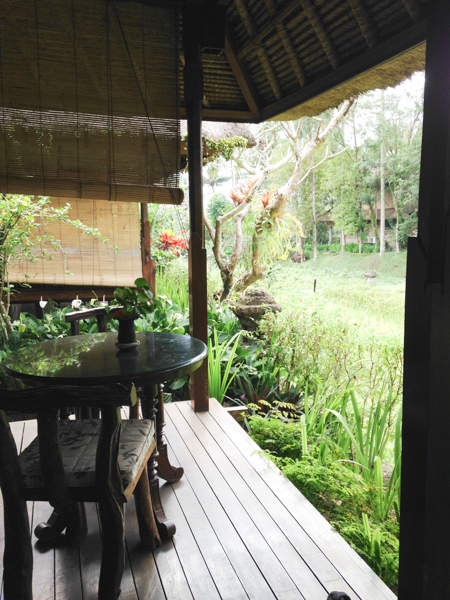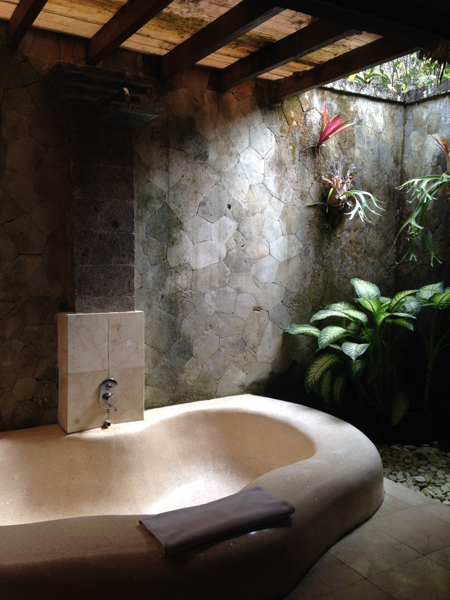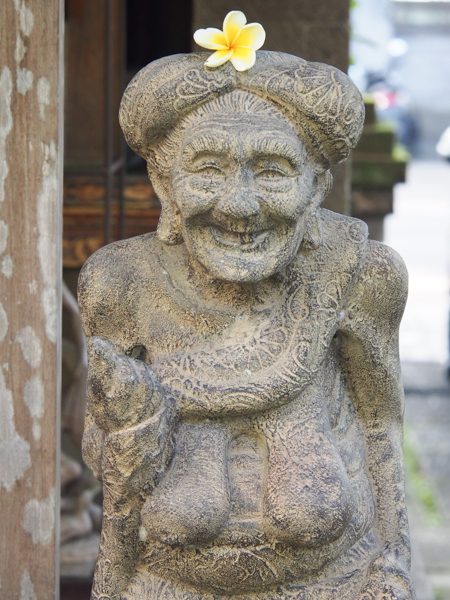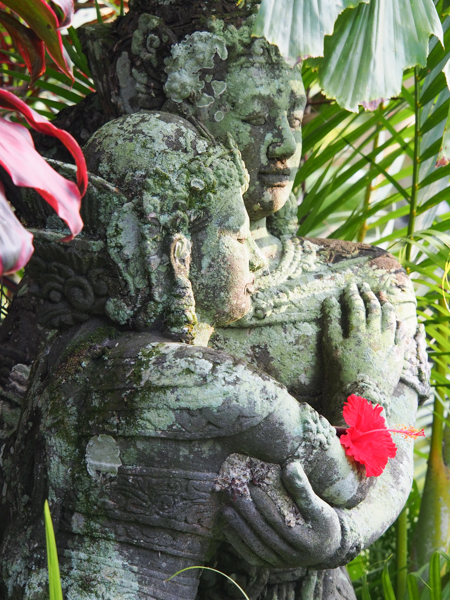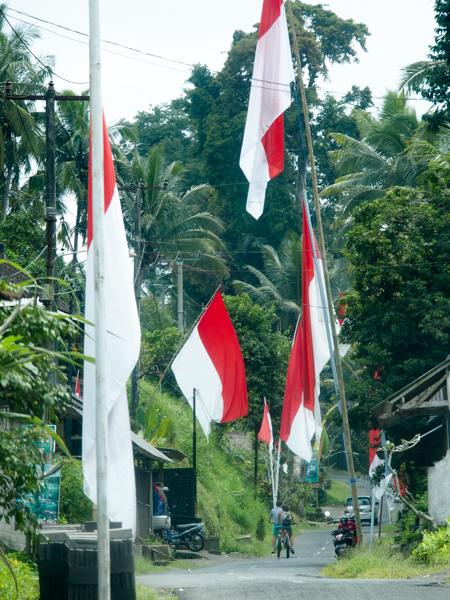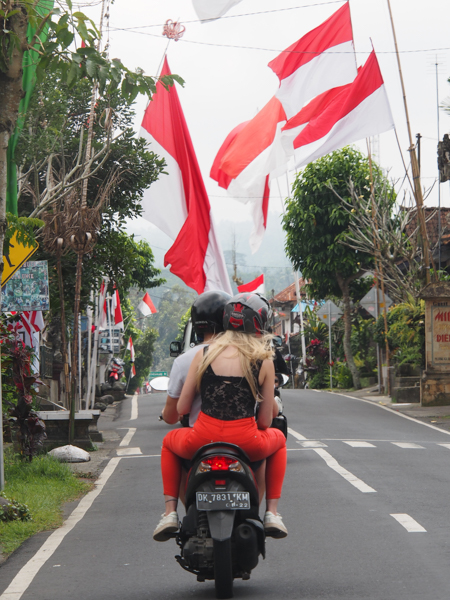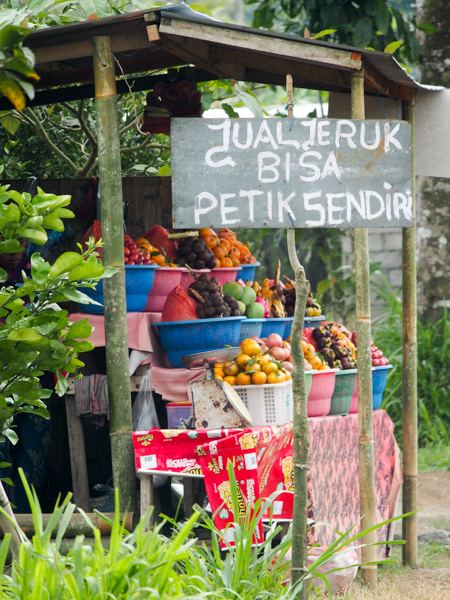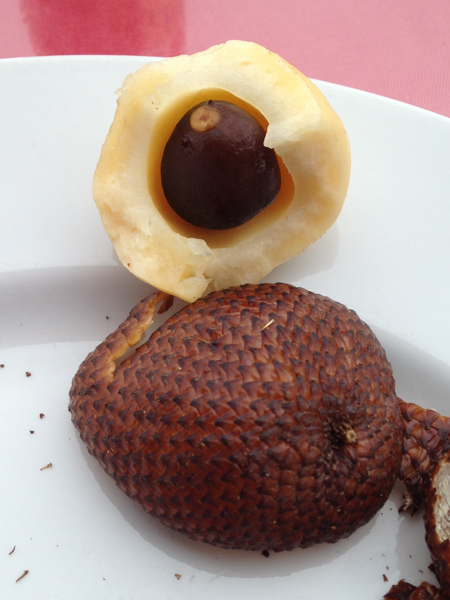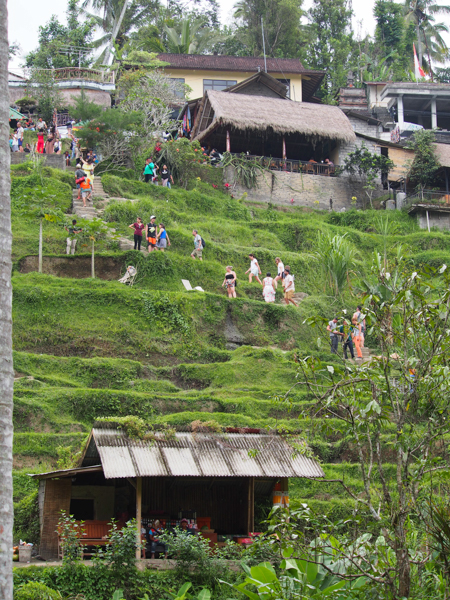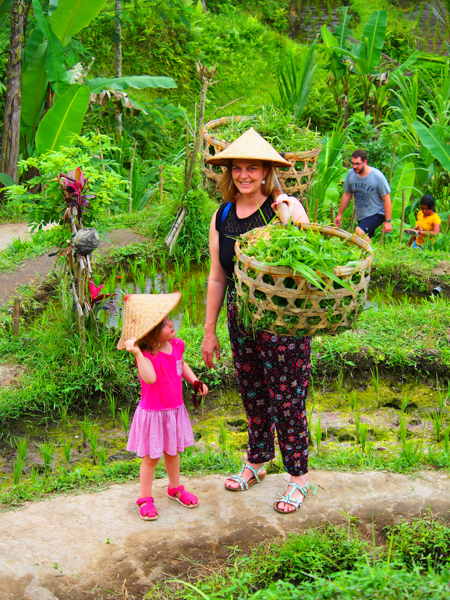We landed at Denpasar airport with the intention of spending a few days in Ubud on the Indonesian island of Bali. After an easy and friendly Customs clearance, we emerged into the main building, an interesting construction of what appear to be modern glass-and-metal tubes running through the decoratively carved red stone gates and walls of an old temple, although in fact the entire structure was recently built as a whole, due to a local bylaw that states that all buildings must have at least some elements of traditional architecture.

Our driver arrived and loaded us into his car. The capital city around the airport is scattered with extremely impressive and flamboyant sculptures of heroic scenes from Hindu mythology, sometimes the size of buildings. The traffic reminded us of downtown Kuala Lumpur, if not India, with families of three and four on little scooters passing us on either side, the ladies often riding side-saddle.
As we reached the outskirts of Ubud, we started to see mopeds carrying entire pop-up food stalls, and in one memorable case, the pillion was steadfastly carrying at full vertical arm’s length not one, but two intact car windscreens.
Out here, there appeared to be at least one temple every few hundred metres, all intricately carved towers and gates. It wasn’t until much later that we realised that these were not temples but regular houses, because every house has at least one “home shrine”, and it is not unusual to have many more.

The roadside was packed with artisans, not only a bewildering number of stone-masons who seemed largely to have the same repertoire of metre-high Hindu gods, but also quarry stonemasons with enormous piles of hand-cut volcanic rock, and wood merchants with sections of hard-wood tree wider than the spread of your arms.
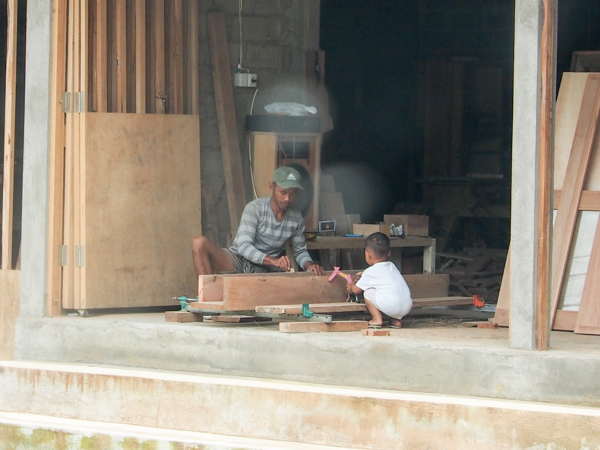
Our hotel comprises a number of thatched chalets scattered amongst rice paddies, coconut palms, and endless statues and flowering trees. It was very picturesque. Our chalet boasted a family-size kidney-shaped stone tub, and an enormous solid wood four-poster bed with thick cotton mosquito-netting.

The staff were very friendly, very relaxed, yet very focussed on making the place look beautiful. Hinduism is the major religion here, and so there is a continual whirl of colour as small baskets of flowers and food are placed thrice daily before each of the ubiquitous shrines, and every day new flowers are tucked into crevices on the myriad stone statues.
Every morning, we were woken to the sound of sweeping, as the staff combed the site for fallen frangipani and other tree flowers, gathering them for use during the day.
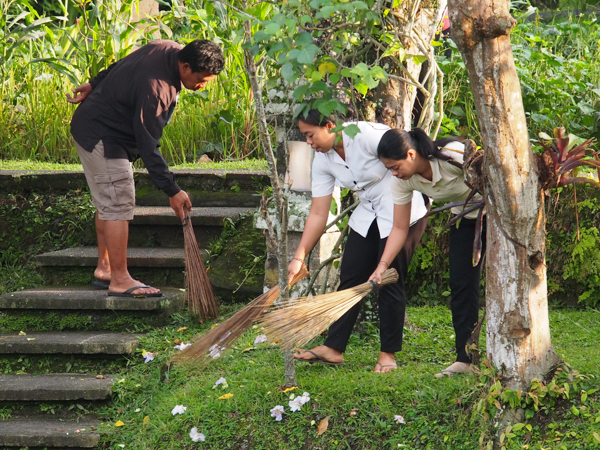

We had hired a driver for the week, Komang from Abracadabra Tours. He had planned a thorough itinerary from which we cherry-picked the more toddler-friendly options.
One day, he took us to see the volcano. This was not Mt Agung, which is famously still erupting and out-gassing, but Mt Batur which hasn’t done anything much since the sixties, although it is still classed as active. We understand that the trek to the top to see the sunrise is a popular pastime, and in the past we would have done that ourselves, but on this occasion we took the child-friendly option and planned to view the peak and the caldera from a ridge-top restaurant.
From the moment that we left Ubud, the road climbed steadily. It was a striking drive, because the flags were still flying from the recent Independence Day celebrations.
The road up from Ubud took us from the sea-level rice-paddies and banana palms, to the higher altitude orange plantations. We stopped at a roadside shack to buy some small sweet tangerines, and also a handful of hard-skinned purple fruit that we ate by sucking out the pith, not completely unlike a pomegranate in flavour. Possibly they were a kind of passion fruit, but nobody we asked seemed to know what they were called. One great hit, though, was the snake fruit, so-called because of its scaly skin, which had lovely firm white flesh reminiscent of a lychee.
We were glad that we’d stopped at the roadside vendor to enjoy the fruit, because when we got to the viewpoint (roadside entry fee applies), there was only a dodgy buffet to eat in the supposed restaurant, on wobbly chairs overlooking a cloud-shrouded peak in the far distance.
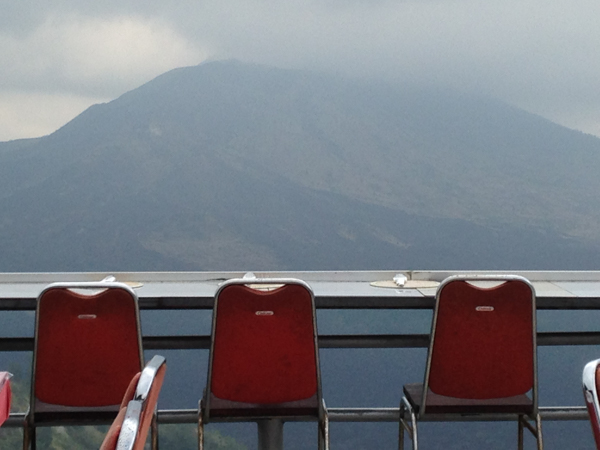
Somewhat underwhelmed both intellectually and gustatorily, we drove back down the mountain to visit another tourist destination, the Kellalalang terraced rice-paddy fields, which seemed like an odd idea because we’d been driving through and walking around terraced paddy fields for the whole day.
Nevertheless, it was one of the region’s attractions, so we drove up to the village (an inevitable roadside entry fee applied) and entered the village. It consisted of a single road lined with wall-to-wall retail outlets all selling exactly the same tat, looking down on what obviously used to be rice paddies but were now an exceedingly well-worn set of concrete steps interspersed with over-priced cafes, children selling postcards, and what seemed to be a recent craze of rope swings slung between palm trees. We handed over our ‘donation’ and clambered down the track, past more child card-sellers and photo-opportunity “rice farmers”, and then, confronted by another donation booth, clambered back up to the retail outlets.
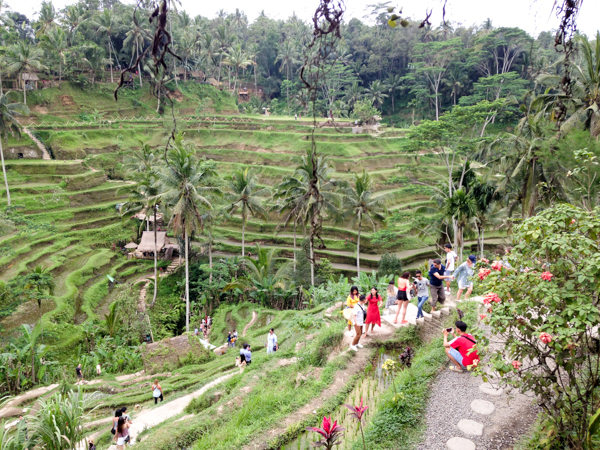
We’d arranged to meet Komang at the driver’s car park a little out of town, and when we arrived we were confronted with a large government sign which warned against the locals soliciting donations, and strongly recommended not descending into the paddies as it “destroyed the unique heritage site”. It would have been nice to have known that ahead of time.
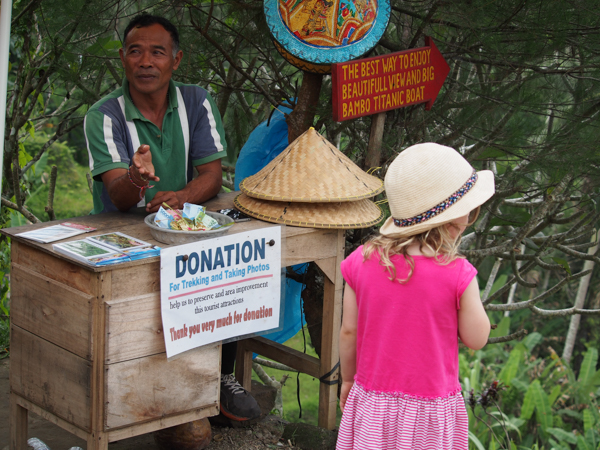
One morning, we booked ‘breakfast with the orang-utans’ at Bali zoo. On our arrival, we were ushered into an outdoor area filled with trestle tables, with a couple of ropes looped overhead for a young orang-utan, and a couple of elephants leaning in over a low fence.

It was quite fun. As well as the usual buffet food, there were short-order chefs sorting out omelettes and so on, and the opportunity to get up from the table and hang out with the orang-utan, elephants, parrots, and even a somewhat nervous pangolin.

Later we toured the zoo itself, which tended heavily to Sumatran and Benghal Tigers, and a wide selection of gibbons. It was quite pretty and the animals seemed in good shape. One nice touch was that all the enclosures were decorated with rock-carvings and the ubiquitous pillar shrines of the rice paddies.
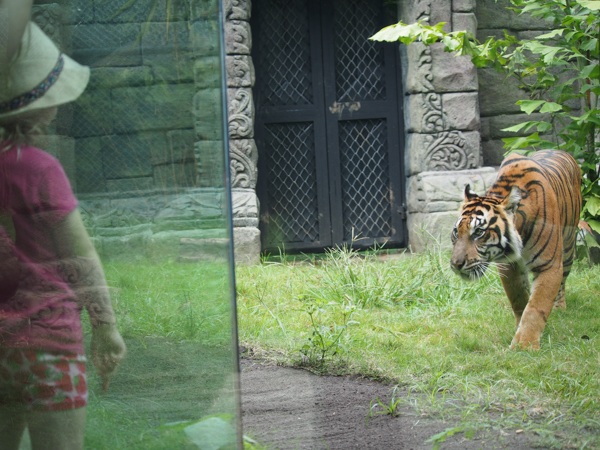
One great aspect of Bali was the ready availability of seriously good massage. Wherever we went, there was always somebody who could come to your room, or drive you to their spa, and then for a handful of notes subject you to a wonderful 90 minutes of pounding and squeezing.
Another facet of the culture is that if you have a car, then you are a driver for hire. Haggling with an official taxi driver outside a water-park one day, we were interrupted by a worker at the park who was going home in his tangerine-and-purple hot-hatch, and offered to drop us off at our hotel for whatever price we cared to pay.
There was no benefit in taking a “proper” taxi anyway. On another day, it started to rain while we were in downtown Ubud. Suddenly all the previously ubiquitous kerbside taxi-touts dissolved out of sight, but we stopped a passing official cab. Once we’d agreed on a price, the driver set off firmly in the wrong direction. It turned out that not only did he not know our hotel, but he didn’t even know the road it was on (ie the main street past Ubud museum), and in any case he didn’t seem to know which way his taxi was pointing.
He had two GPS units but one wasn’t working, and he didn’t seem to be able to use the other one. Finally Bronwyn fired up her own GPS and gave him directions, but at every turn he shook his head and demurred “one way” although it clearly wasn’t, until he smiled in shocked amazement when we popped out on the main street, facing in the correct direction.
